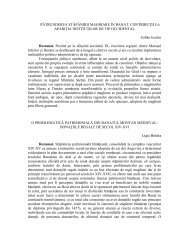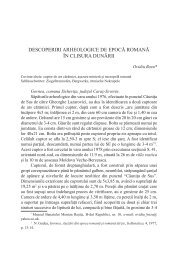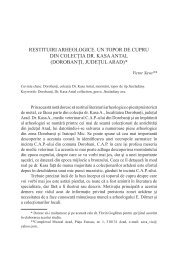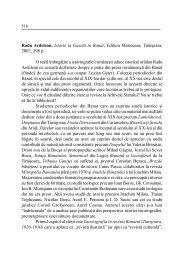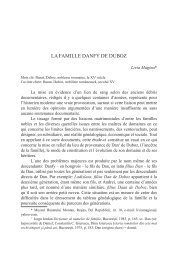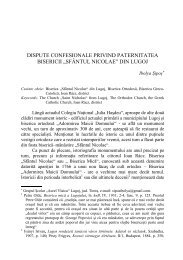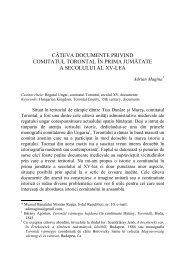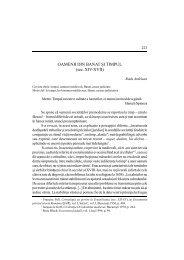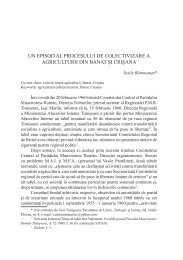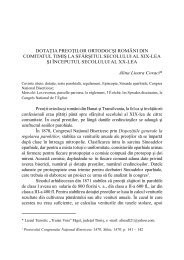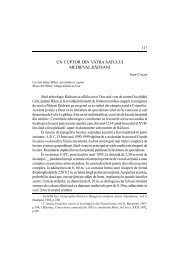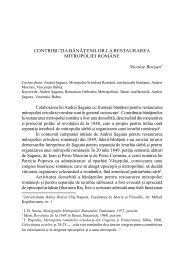Alexandru Simon - Banatica
Alexandru Simon - Banatica
Alexandru Simon - Banatica
Create successful ePaper yourself
Turn your PDF publications into a flip-book with our unique Google optimized e-Paper software.
to strike Istanbul and coerce Krakow. Maximilian I overlooked the fact that the<br />
Crimean Tartars were one of Selim I’s most trusted supporters. He seemingly<br />
also overestimated his grip on Walachian matters (a year later he did the same).<br />
Walachia was under sultan Selim’s firm control, after Neagoe Basarab, the<br />
favorite of the Ecumenical Patriarchate and of the Orthodox monastic and secular<br />
elites around it, had won the sultan’s favor (Neagoe had been enthroned against<br />
Selim’s will) and also rapidly gained domestic support (1512-1513). The<br />
Ottomans could thus launch their raids against Hungary. These raids increased<br />
in intensity after Selim’s victory over Ahmed in spring 1513 (Wladislaw II even<br />
sent word to remote Görlitz that Selim I, Neagoe Basarab and the Tartars had<br />
occupied Transylvania and planned to divided Hungary’s eastern province among<br />
themselves). The riders were however not the only Ottoman figures and forces<br />
crossing the Danube line in the first half of 1513. Patriarch Pachomios too<br />
came to Walachia and Moldavia in an attempt to exploit also Greek ‘millennarist’<br />
fears (1512, year marked by natural catastrophes in Moldavia, should have<br />
brought the end of the world). Bogdan III reconciled with the patriarchate.<br />
Stephen III’s son made penitence in front of Pachomios and of Moldavian<br />
metropolite Theoctiste II for (his ‘anti-Greek’ and pro-Latin) deeds 12 .<br />
Pachomios’ timing was precise. The papal seat was vacant. Bogdan III<br />
wanted to remarry and was in close relations to emperor Maximilian I. Together<br />
with Wladislaw (relations between Buda and Suceava had bettered), Bogdan<br />
III planned to dethrone Neagoe, the patriarch’s protégé and a major threat to<br />
Moldavia’s Greek and Walachian prestige and interests. Pachomios’ mission<br />
12 Staatsarchiv, Görlitz, Handschriften, ff. 211 v -212 r (edited in [Johannes Hasse], Mag. Johannes<br />
Hasse Burgermeisters zu Goerlitz Goerlitzer Rathsannalen, I, Erster und zweiter Band (1509-<br />
1520) (=Scriptores Rerum Lusaticarum, NS, III), edited by Theodor Neumann, Görlitz, 1852, p.<br />
261-263, Al. <strong>Simon</strong>, Neagoe Basarab, Imperiul Otoman şi Transilvania în 1513, in Studia<br />
Varia in Honorem Professoris Ştefan Ştefănescu Octogenarii, edited by Ionel Cândea, Cristian<br />
Luca, Bucharest-Brăila, 2009, p. 311-320; Erich Joachim, Walter Hubatsch, Regesta historicodiplomatica<br />
Ordinis S. Mariae Theutonicorum 1198-1525, I-1, Urkunden 1198-1525, Göttingen,<br />
1948, no. 74, p. 229; no. 82, p. 237; Sanudo, XIX, 1 Settembre 1514-28 Febbraio 151, 1887,<br />
col. 87; Viaţa sfântului Nifon, edited by Vasile Grecu, Bucharest, 1944, p. 94-95; Malaxos, p.<br />
140; N. Iorga, Românii şi Muntele Athos, in AARMSI, 2 nd Series, XXXVI, 1914, p. 207-253 (p.<br />
231-232); Mustafa A. Mehmet, Două documente turceşti despre Neagoe Basarab, in Studii,<br />
XXI, 1968, 5, p. 923-928; Al. <strong>Simon</strong>, The Walachians between Crusader Crisis and Imperial<br />
Gifts (Mid 1400s and Early 1500s), in AIRCRU, IX, 2007, p. 141-191 (p. 175-183). Vienna,<br />
Buda, Rome and crusading in the early 1510s: H. Wiesflecker, Neue Beiträge zur Frage des<br />
67



